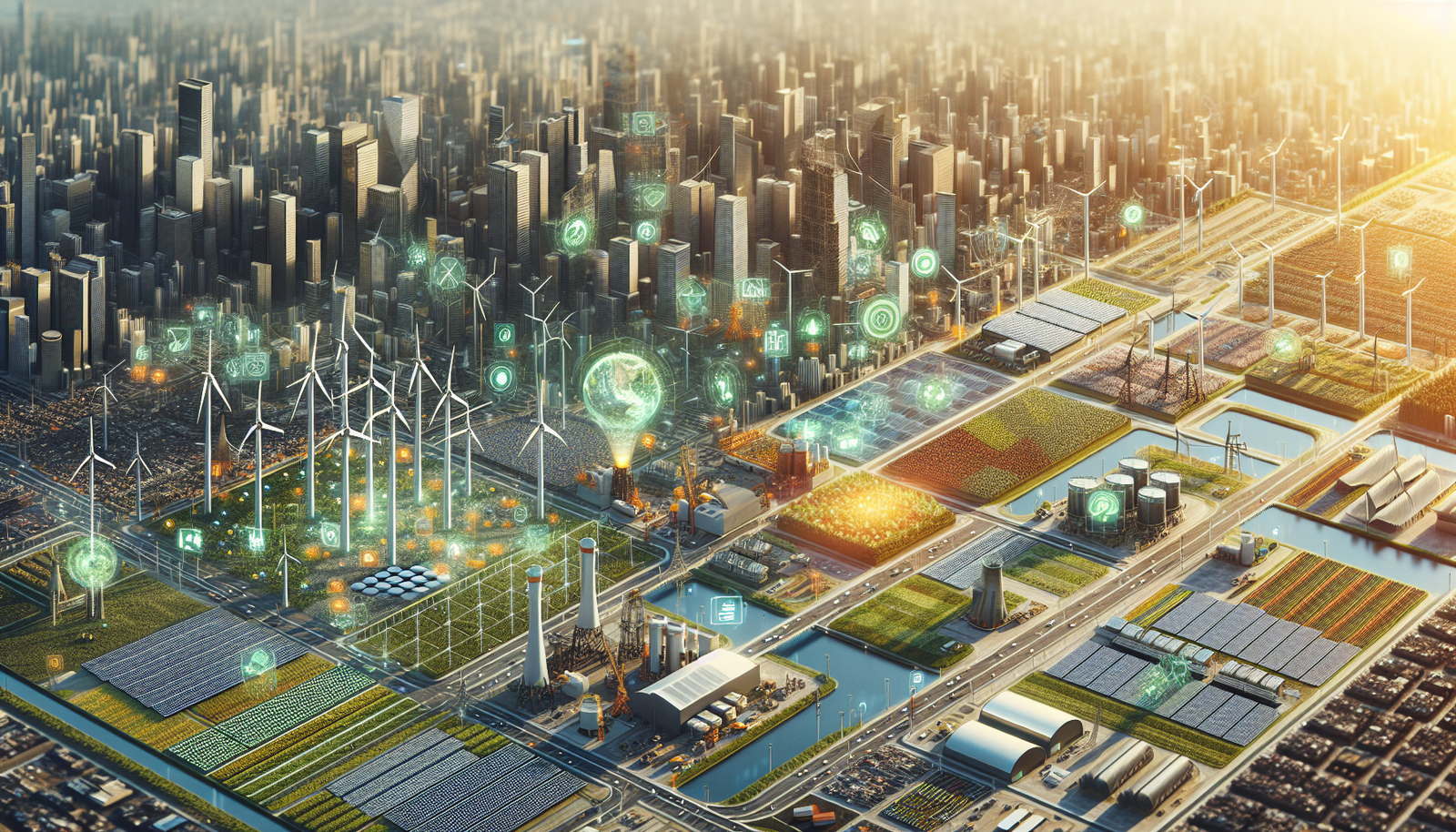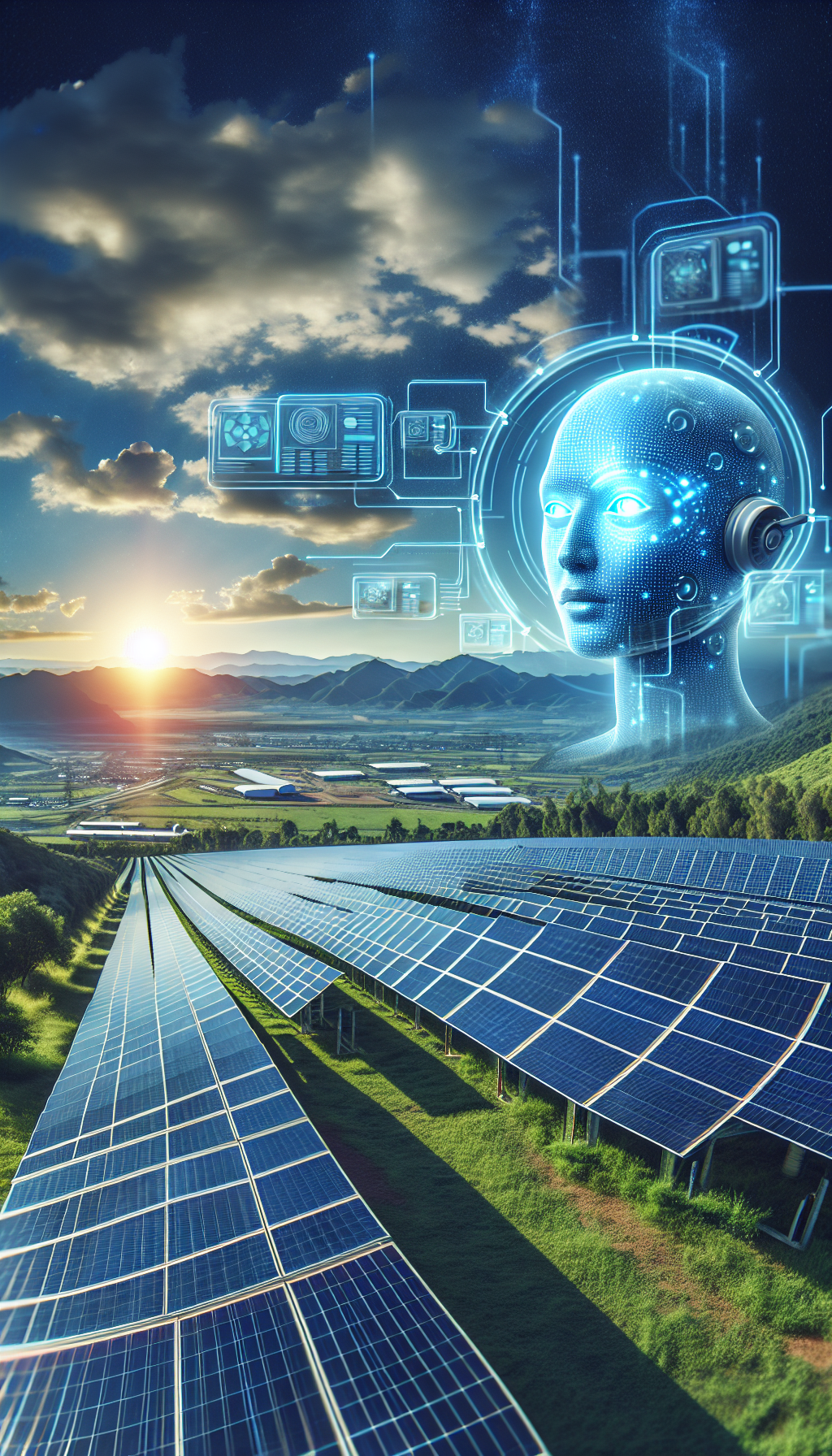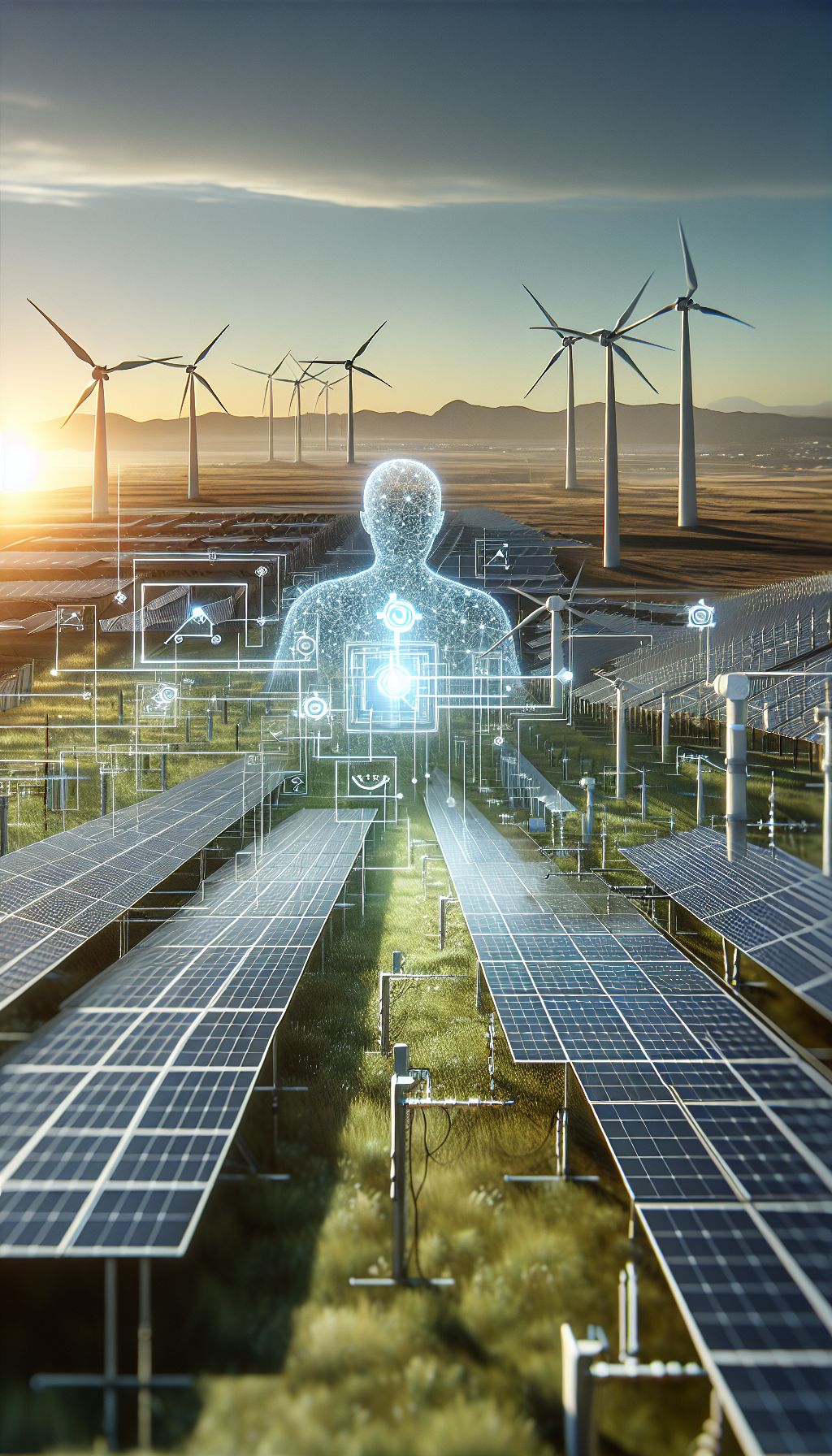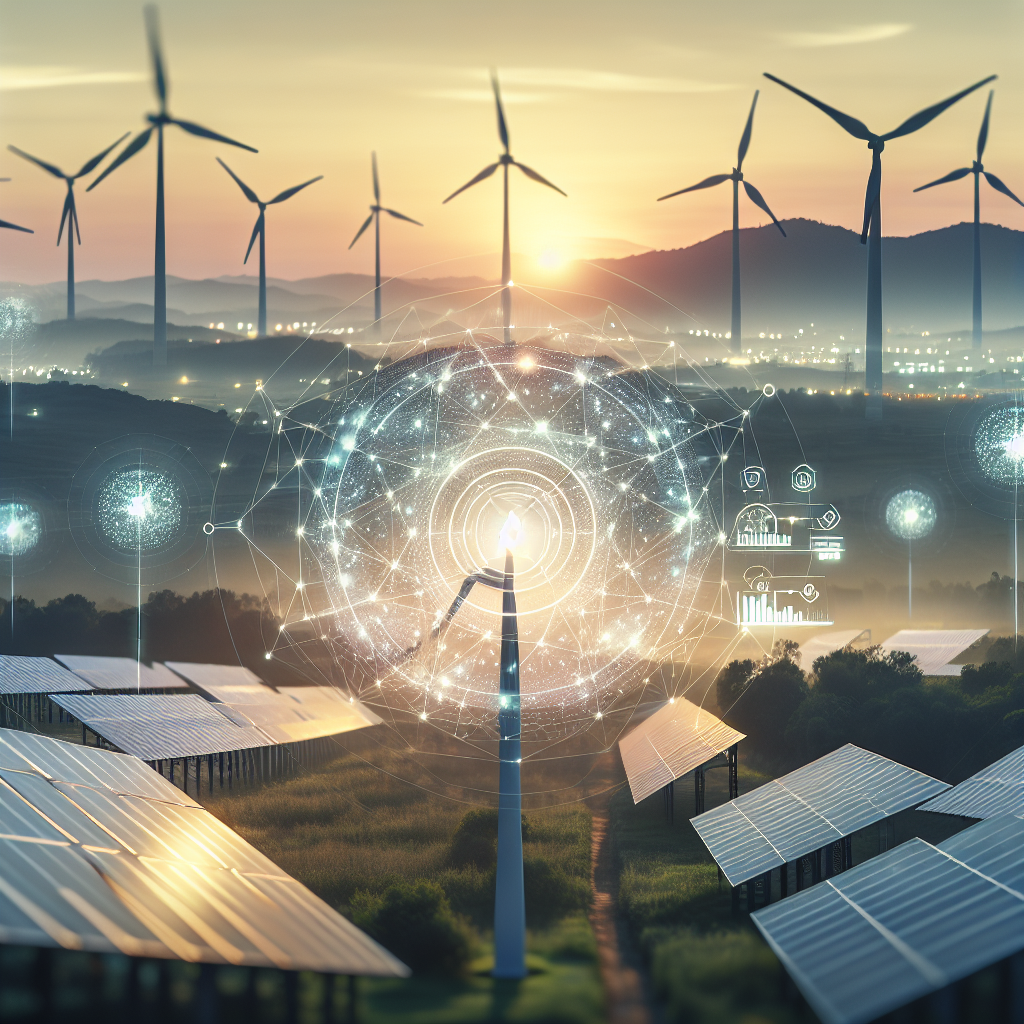Introduction to AI and Sustainability
Artificial Intelligence (AI) has emerged as a transformative technology with the potential to address some of the most pressing challenges of our time, particularly in the realm of sustainability. As the world grapples with climate change, resource depletion, and environmental degradation, AI offers innovative solutions that can enhance efficiency, reduce waste, and promote sustainable practices across various sectors.
At its core, AI leverages advanced algorithms and data analytics to process vast amounts of information, enabling systems to learn, adapt, and make informed decisions. This capability is particularly valuable in sustainability initiatives, where complex data sets and dynamic environmental conditions require sophisticated analysis and real-time responsiveness. By integrating AI into sustainability efforts, organizations can optimize resource use, predict environmental impacts, and implement proactive measures to mitigate adverse effects.
Several industries are already witnessing the benefits of AI-driven sustainability. For instance, in the renewable energy sector, AI algorithms are used to predict energy production from solar and wind sources, allowing for better grid management and energy storage solutions. In smart agriculture, AI-powered systems monitor crop health and soil conditions, enabling farmers to apply precise amounts of water, fertilizers, and pesticides, thereby reducing resource consumption and environmental impact.
Moreover, AI plays a crucial role in waste management and water conservation. Machine learning models can optimize recycling processes by identifying and sorting materials more accurately, while AI-driven water management systems can detect leaks and monitor water quality in real-time. These applications not only enhance operational efficiency but also contribute to broader environmental sustainability goals.
AI in Renewable Energy Management
Artificial Intelligence (AI) is playing a pivotal role in the management of renewable energy resources. As the world increasingly shifts towards sustainable energy solutions, the integration of AI technologies is proving to be a game-changer. AI systems are being utilized to enhance the efficiency, reliability, and predictability of renewable energy sources, such as solar and wind power. By analyzing vast amounts of data, AI can optimize energy production and distribution, ensuring that renewable energy is harnessed to its fullest potential.
One of the significant applications of AI in renewable energy is in predictive maintenance. AI algorithms can predict equipment failures before they occur, reducing downtime and maintenance costs. For instance, wind turbines equipped with AI sensors can monitor vibrations, temperature, and other parameters in real-time. When the AI detects anomalies that may indicate a potential failure, it can alert maintenance teams to take preemptive action. This not only extends the lifespan of the equipment but also maximizes energy production by minimizing interruptions.
Another crucial application is in energy forecasting. AI models can analyze weather patterns, historical data, and other variables to forecast energy production from renewable sources with high accuracy. For example, AI can predict the amount of sunlight a solar farm will receive or the wind speed at a wind farm, allowing operators to plan and manage the energy grid more efficiently. This helps in balancing supply and demand, reducing the reliance on non-renewable backup sources, and minimizing energy wastage.
AI also enables smart grid management. A smart grid uses AI to monitor and manage the distribution of electricity in real-time. By analyzing data from various sensors and meters across the grid, AI can optimize the flow of electricity, reduce losses, and ensure a stable supply. This is particularly important for integrating intermittent renewable energy sources, such as solar and wind, into the grid. With AI, energy providers can better manage the variability and unpredictability of renewable energy, ensuring a reliable and sustainable energy supply.
Smart Agriculture and Precision Farming
Smart agriculture, empowered by AI, is transforming traditional farming practices into more efficient and sustainable operations. By leveraging machine learning algorithms and sensor technology, farmers can gather and analyze vast amounts of data related to soil health, weather patterns, crop health, and pest activity. This data-driven approach allows for more precise farming techniques, reducing waste and improving crop yields.
One of the key components of smart agriculture is precision farming. Precision farming involves the use of AI and IoT devices to monitor and optimize agricultural practices in real-time. For instance, AI algorithms can analyze data from soil sensors to determine the exact amount of water and nutrients needed for different parts of a field, leading to significant water conservation and enhanced crop growth.
- Soil Health Monitoring: AI-powered sensors can detect soil moisture levels, pH, and nutrient content, providing farmers with accurate data to make informed decisions about irrigation and fertilization.
- Weather Prediction: Advanced AI models can predict weather changes with high accuracy, allowing farmers to plan their planting and harvesting schedules more effectively.
- Pest and Disease Management: AI can identify early signs of pest infestations and plant diseases, enabling timely and targeted interventions that minimize crop loss and reduce the need for chemical pesticides.
The benefits of smart agriculture are already being realized in various regions. In India, for example, the use of AI in farming has led to a 30% increase in crop yields and a 20% reduction in water usage. Similarly, in the United States, precision farming technologies have helped farmers decrease the use of fertilizers by 15%, leading to both economic and environmental benefits.
AI for Waste Management and Recycling
Artificial Intelligence is playing a pivotal role in transforming waste management and recycling processes. Traditional waste management systems often struggle with inefficiencies and inaccuracies, leading to increased costs and environmental pollution. AI-driven solutions, however, are bringing about a significant change by optimizing waste sorting, improving recycling rates, and reducing landfill usage. For instance, AI-powered robotics equipped with sensors and machine learning algorithms can accurately identify and sort different types of waste materials. This not only speeds up the sorting process but also minimizes human error.
One notable example is the use of AI in automated waste sorting systems. These systems utilize computer vision technology to scan and classify waste items on conveyor belts. The data collected from these systems can be used to train machine learning models to become more accurate over time. According to a study by the Ellen MacArthur Foundation, AI-driven waste sorting can increase recycling rates by up to 20%. This improvement not only enhances the efficiency of recycling facilities but also conserves valuable resources and reduces greenhouse gas emissions associated with waste treatment.
Another innovative application of AI in waste management is predictive analytics for waste collection. AI algorithms can analyze data from various sources, such as population density, seasonal trends, and waste production patterns, to optimize waste collection schedules. This ensures that waste is collected more efficiently, reducing the number of collection trips and lowering fuel consumption and emissions. Cities like Barcelona and Singapore have already implemented AI-based waste collection systems, resulting in significant cost savings and environmental benefits.
AI is also being utilized to tackle the challenge of electronic waste (e-waste) management. E-waste contains hazardous materials that can harm the environment if not disposed of properly. AI technologies can help identify valuable components within e-waste, enabling more effective recycling and recovery of precious metals such as gold, silver, and platinum. By integrating AI into e-waste recycling processes, companies can not only reduce environmental pollution but also recover valuable resources that contribute to a circular economy.
AI in Water Conservation
Water conservation is a critical component of sustainable development, and AI is playing a pivotal role in this area. By leveraging advanced algorithms and machine learning, AI systems can analyze vast amounts of data to optimize water usage in agriculture, industry, and urban settings. For instance, AI-driven irrigation systems use real-time data from soil sensors, weather forecasts, and satellite imagery to precisely control water distribution, ensuring that crops receive the exact amount of water they need, thus minimizing waste.
One notable example of AI in water conservation is the use of AI-powered leak detection systems in urban water supply networks. These systems employ machine learning algorithms to monitor water flow and pressure in real-time, identifying anomalies that may indicate leaks. Early detection of leaks not only prevents water loss but also reduces the risk of infrastructure damage. In fact, cities that have implemented AI-driven leak detection have reported up to a 30% reduction in water loss.
Moreover, AI is instrumental in predicting and managing water demand. By analyzing historical usage patterns and correlating them with variables like population growth and climate change, AI models can forecast future water needs with high accuracy. This information is invaluable for water resource managers, enabling them to make informed decisions about reservoir levels, water distribution, and emergency response plans during drought conditions.
AI’s impact on water conservation extends to wastewater management as well. Advanced AI systems can optimize the operations of wastewater treatment plants by predicting the optimal times for maintenance and adjusting treatment processes based on real-time water quality data. This not only ensures compliance with environmental regulations but also reduces operational costs. As a result, AI is helping to create more sustainable and efficient water management practices across various sectors.
Sustainable Urban Planning with AI
Urban planning is a critical component in the pursuit of sustainability, and AI is playing an increasingly prominent role in shaping smarter, greener cities. AI-driven urban planning tools utilize vast amounts of data to create more efficient and sustainable city designs. These tools can analyze traffic patterns, energy consumption, and even social behaviors to optimize urban layouts. For instance, AI can help in identifying the best locations for green spaces, which not only improve air quality but also enhance the well-being of city residents.
One notable application of AI in urban planning is in the optimization of transportation systems. AI algorithms can predict traffic congestion and suggest alternative routes, reducing carbon emissions and improving air quality. Moreover, AI can be used to design intelligent public transportation networks that are both efficient and environmentally friendly. Cities like Singapore and Amsterdam are pioneers in using AI to create smart transportation systems, resulting in significant reductions in traffic congestion and pollution.
Another significant contribution of AI to sustainable urban planning is in energy management. AI systems can monitor and manage the energy consumption of buildings, ensuring that they operate at peak efficiency. For example, AI can predict energy demand and adjust heating, cooling, and lighting systems accordingly. This not only reduces energy waste but also lowers greenhouse gas emissions. Additionally, AI can integrate renewable energy sources into the urban grid, balancing supply and demand to maximize the use of clean energy.
AI is also revolutionizing waste management in urban areas. Predictive analytics can forecast waste generation patterns, enabling more efficient waste collection and recycling processes. By identifying areas with high waste generation, city planners can allocate resources more effectively and reduce the environmental impact of waste disposal. AI-powered sorting systems can even automate the separation of recyclables from waste, increasing recycling rates and reducing landfill use.
AI in Climate Change Modeling
Artificial Intelligence (AI) has become a pivotal tool in climate change modeling, providing more accurate predictions and enabling better decision-making for mitigation and adaptation strategies. Traditional climate models often rely on complex equations and vast amounts of data to simulate the Earth’s climate. However, these models can be limited by computational constraints and the inherent complexity of climate systems. AI, particularly machine learning algorithms, can process and analyze vast datasets more efficiently, identifying patterns and making predictions that were previously unattainable.
One significant application of AI in climate change modeling is in improving the precision of weather forecasts and climate projections. For instance, neural networks can be trained on historical weather data to predict future climate conditions with greater accuracy. These models can incorporate a wide range of variables, such as temperature, precipitation, and greenhouse gas concentrations, to simulate different climate scenarios. This enhanced predictive capability is crucial for developing effective climate policies and strategies.
Additionally, AI-driven models can assist in identifying and understanding the complex interactions between various climate factors. For example, AI can analyze the impact of deforestation on regional climate patterns or the effect of ocean temperature changes on global weather systems. By uncovering these intricate relationships, AI helps scientists develop more comprehensive and informed climate models.
Data visualization plays a crucial role in AI-driven climate change modeling, making complex data more accessible and understandable. Visual tools such as heatmaps, time-series graphs, and interactive maps can illustrate the predicted impacts of climate change under different scenarios. These visualizations can be used to communicate findings to policymakers, stakeholders, and the general public, fostering greater awareness and informed decision-making.
Corporate Sustainability Initiatives Using AI
Corporations worldwide are increasingly harnessing the power of Artificial Intelligence (AI) to drive their sustainability initiatives. By leveraging AI, companies can optimize resource consumption, reduce waste, and enhance operational efficiency. One of the key areas where AI is making a significant impact is in energy management. For instance, tech giants like Google have implemented AI systems to manage their data centers, resulting in a 40% reduction in energy consumption. These AI systems analyze data from thousands of sensors to optimize cooling systems, ultimately reducing the carbon footprint.
In addition to energy management, AI is also transforming supply chain operations. Companies like Unilever are using AI to predict demand accurately, thereby minimizing overproduction and waste. AI algorithms analyze a variety of data points, from weather patterns to social media trends, enabling more precise demand forecasting. This not only reduces waste but also lowers greenhouse gas emissions associated with excess production and transportation. Here is a visualization of the impact:
| Company | AI Application | Sustainability Impact |
|---|---|---|
| Energy Management | 40% reduction in energy consumption | |
| Unilever | Demand Forecasting | Reduction in overproduction and waste |
Another notable example is IBM, which is utilizing AI-driven analytics to enhance water conservation efforts in industrial processes. By analyzing real-time data from sensors installed in manufacturing plants, AI algorithms can identify leaks and inefficiencies, allowing for prompt corrective actions. This has led to significant water savings and has underscored the potential of AI in promoting sustainable industrial practices.
Lastly, AI is playing a crucial role in the development of sustainable products. Companies like Nike are using AI to design products with minimal environmental impact. AI-driven design tools enable the creation of prototypes that use fewer materials and generate less waste. These initiatives not only contribute to environmental sustainability but also align with the growing consumer demand for eco-friendly products. Through these examples, it is evident that AI is a powerful catalyst for corporate sustainability, driving innovations that lead to a more sustainable future.
AI and Green Transportation
AI is playing an instrumental role in transforming the transportation sector into a more sustainable and environmentally friendly domain. One of the primary ways AI contributes to green transportation is through the optimization of routes for public transit systems. By analyzing vast amounts of data, including traffic patterns, weather conditions, and passenger demand, AI algorithms can devise the most efficient routes that reduce fuel consumption and minimize greenhouse gas emissions. This not only helps in decreasing the carbon footprint but also enhances the overall efficiency and reliability of public transportation.
Another significant application of AI in green transportation is in the development and deployment of autonomous electric vehicles (EVs). These AI-driven EVs are designed to operate with maximum energy efficiency, reducing the reliance on fossil fuels. For instance, AI systems can manage battery usage in real-time, optimizing energy consumption based on driving conditions and routes. This leads to longer battery life and fewer charging stops, making electric vehicles more practical and appealing to consumers.
Moreover, AI is being utilized to improve the management of transportation infrastructure. Smart traffic management systems powered by AI can predict congestion patterns and adjust traffic signals accordingly to ensure smoother traffic flow. This reduces idling times at intersections and cuts down on fuel wastage. In addition, AI can assist in predictive maintenance of transportation infrastructure, such as bridges and roads, by identifying potential issues before they become major problems, thus preventing costly repairs and reducing resource consumption.
AI’s impact on green transportation extends to the logistics and freight industry as well. By optimizing delivery routes and schedules, AI can significantly reduce the number of vehicles on the road and the distance they travel, leading to lower emissions. For example, AI algorithms can consolidate shipments and plan routes that avoid high-traffic areas, further contributing to a decrease in fuel consumption and emissions.
Energy Efficiency in Manufacturing
The integration of Artificial Intelligence (AI) in manufacturing processes has led to significant advancements in energy efficiency. AI-driven systems can analyze vast amounts of data in real-time to optimize energy usage, reducing waste and lowering costs. For instance, AI algorithms can predict equipment maintenance needs, thereby minimizing downtime and improving operational efficiency. Furthermore, machine learning models can identify patterns in energy consumption, enabling manufacturers to adjust their processes to be more energy-efficient.
Case Study: General Electric (GE)
General Electric (GE) has implemented AI-driven solutions to enhance energy efficiency across its manufacturing plants. By using AI to monitor and analyze data from various machines, GE has been able to optimize energy consumption, leading to a 20% reduction in energy costs. The AI systems can predict when a machine is likely to fail, allowing for preemptive maintenance and reducing energy waste.
Key Benefits
- Reduced Energy Consumption: AI technologies help in identifying and eliminating inefficiencies in energy usage.
- Cost Savings: Optimized energy use translates to significant cost reductions for manufacturers.
- Improved Maintenance: Predictive maintenance reduces downtime and improves overall efficiency.
Data Visualization: Energy Consumption Reduction
| Month | Energy Consumption (kWh) | Energy Cost ($) |
|---|---|---|
| January | 500,000 | 50,000 |
| February | 480,000 | 48,000 |
| March | 460,000 | 46,000 |
| April | 440,000 | 44,000 |
The above table illustrates the monthly reduction in energy consumption and associated cost savings at a manufacturing plant that has implemented AI-driven energy efficiency measures. Over a period of four months, the plant achieved a steady decline in both energy usage and costs, demonstrating the tangible benefits of AI integration in manufacturing.
AI-Powered Sustainable Supply Chains
The integration of artificial intelligence into supply chain management has become pivotal in driving sustainability. AI-powered systems can analyze vast amounts of data to optimize logistics, reduce waste, and ensure responsible sourcing. For instance, AI algorithms can predict demand accurately, which helps in minimizing overproduction and reducing inventory-related waste. Additionally, these systems can optimize routing for transportation, significantly cutting down on fuel consumption and carbon emissions.
One of the notable applications of AI in supply chains is in the realm of predictive maintenance. By utilizing machine learning models, companies can forecast equipment failures before they occur, thereby preventing downtime and reducing the need for emergency repairs. This not only enhances efficiency but also extends the lifespan of machinery, contributing to a more sustainable operational model. Moreover, AI-driven analytics enable companies to monitor the environmental impact of their supply chains in real-time, providing actionable insights for continuous improvement.
AI also plays a crucial role in ensuring ethical sourcing. Machine learning models can analyze supplier data to detect any signs of non-compliance with sustainability standards. By leveraging natural language processing, companies can scrutinize audit reports, social media, and news articles to ensure that their suppliers adhere to ethical practices. This level of transparency is essential for maintaining a sustainable and responsible supply chain.
Data visualization tools are instrumental in making sense of the complex datasets generated by AI systems. For example, interactive dashboards can display key sustainability metrics such as carbon footprint, energy consumption, and waste reduction in a clear and concise manner. These visualizations enable stakeholders to quickly grasp the impact of their supply chain activities and make informed decisions. Below is a sample table illustrating the impact of AI on various supply chain metrics:
| Metric | Traditional Supply Chain | AI-Enhanced Supply Chain |
|---|---|---|
| Carbon Emissions (tons/year) | 500 | 350 |
| Energy Consumption (MWh/year) | 10,000 | 7,500 |
| Waste Reduction (%) | 10% | 25% |
Biodiversity and Wildlife Conservation
Biodiversity and wildlife conservation are critical areas where AI is making significant contributions. By leveraging advanced algorithms and machine learning techniques, researchers are now able to monitor and protect ecosystems more efficiently. AI-powered drones, for instance, are being used to survey vast areas of land, capturing high-resolution images that can be analyzed to track animal populations and their movements. This has been particularly beneficial in regions where traditional monitoring methods are either too costly or impractical.
One notable example is the use of AI to combat poaching. Conservationists have developed AI systems capable of analyzing data from various sources such as camera traps, acoustic sensors, and satellite images. These systems can detect unusual activities and alert rangers in real-time, significantly improving response times. In South Africa, AI-based platforms have reduced poaching incidents by as much as 54% in some national parks.
AI is also being used to restore habitats. Machine learning models can predict which areas are most likely to benefit from reforestation or other restoration efforts, optimizing the allocation of resources. In the Amazon rainforest, AI has helped identify regions that, if restored, could sequester large amounts of carbon, thus aiding in the fight against climate change. Moreover, predictive modeling helps in understanding the impacts of climate change on different species, enabling proactive measures to safeguard them.
Data visualization plays a pivotal role in these initiatives. Interactive maps and graphs generated by AI tools provide a clear picture of biodiversity trends and conservation outcomes. For example, a heatmap might show the density of a particular species over time, helping scientists to quickly identify areas of concern. Similarly, line graphs depicting population changes can guide policy decisions and conservation strategies. These visualizations not only make the data more accessible but also foster greater transparency and collaboration among stakeholders.
Challenges and Ethical Considerations
While AI-driven sustainability initiatives offer promising solutions, they are not without their challenges and ethical considerations. One of the primary challenges is the data quality and availability. AI systems require vast amounts of high-quality data to function effectively. In many sectors, particularly in developing countries, the necessary data either does not exist or is not readily accessible. Additionally, the integration of AI in existing systems can be complex and costly, often requiring significant investment in infrastructure and training.
Another critical aspect to consider is the ethical implications of AI deployment. AI algorithms can inadvertently perpetuate biases present in their training data, leading to unfair or discriminatory practices. For example, in smart agriculture, biased data could result in unequal resource distribution, favoring certain communities over others. Ensuring transparency and accountability in AI systems is crucial to mitigate these risks. This can be addressed through the implementation of robust auditing frameworks and the involvement of diverse stakeholder groups in the development process.
Privacy concerns also pose a significant ethical challenge. The deployment of AI in sustainability efforts often involves the collection and analysis of large amounts of personal and sensitive data. Ensuring that this data is handled responsibly and that individuals’ privacy is protected is paramount. This includes adhering to data protection regulations, such as the General Data Protection Regulation (GDPR) in the European Union, and employing advanced data anonymization techniques.
Lastly, there is the issue of energy consumption associated with AI technologies themselves. Training advanced AI models can be highly energy-intensive, potentially offsetting some of the environmental benefits they are designed to achieve. To address this, researchers are exploring more energy-efficient algorithms and hardware, as well as the use of renewable energy sources to power data centers.



